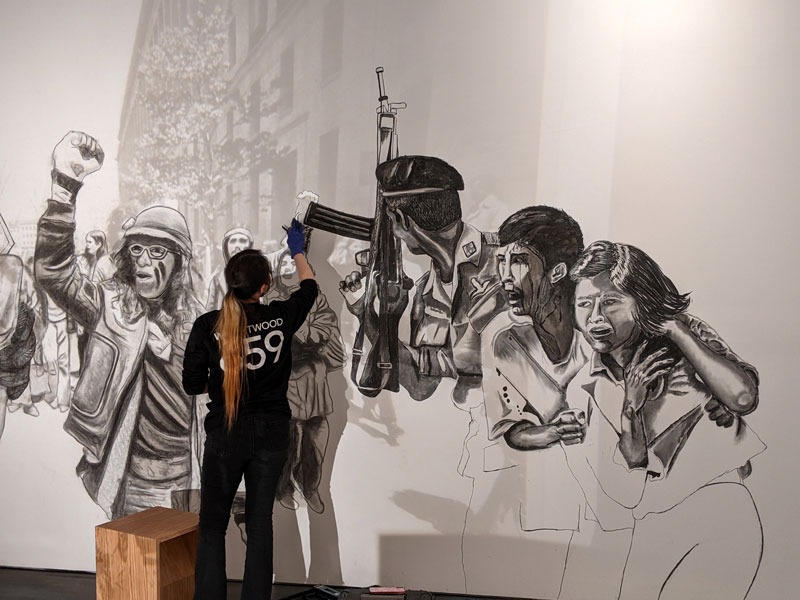
We have specific notions about what a thinker is. Because of the intellectual gifts we associate with those engaged with pursuits of the mind, we often envision philosophers and theoreticians. Rarely do we think of artists. A trio of new exhibits now being shown at Wrightwood 659 help to broaden our notion of who leads and creates through thought. All three are filled with the beauty you expect from an eminent art gallery. Each exhibit goes a step beyond by tying its art to the realities of our everyday lives. One makes us see the commonplace with fresh eyes. Another looks at how a segment of women in 1930s Japan process their exposure to the western world. The third almost acts as a dramatization happening in real time. Emulating Thai artist Rirkrit Tiravanija, local artists draw images of social and political protests on the walls of a space transformed into a common multi-use area.
Established in the Fall of 2018, Wrightwood 659 has always been focused on just two spheres of art; architecture and art that is socially relevant. As they do in this show collective, it’s not unusual to see the two branches co-existing and augmenting the impact of the other.
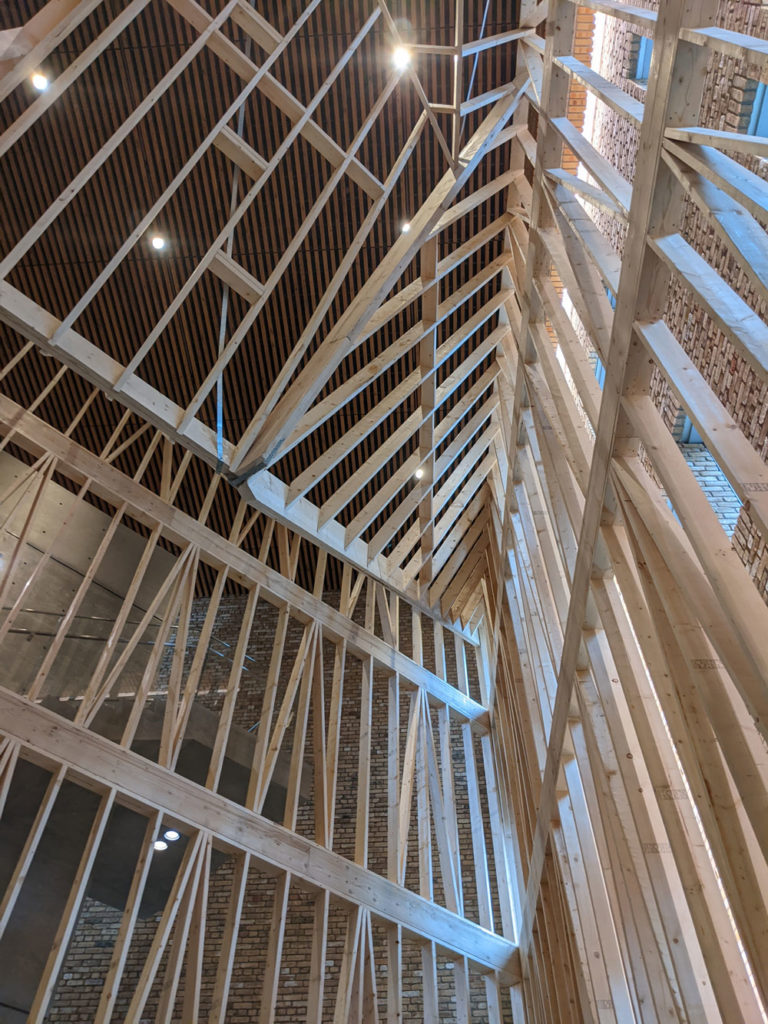
AMERICAN FRAMING elevates the wood framing used to build houses and shows us how to pause long enough to see beyond the known. The exhibit’s curators make the experience tactile by building a towering wood frame structure in the footprint of the gallery’s atrium. Think of a small one room schoolhouse with a ceiling’s that four stories tall sitting in the lobby of a building. No walls, only wood frame. Standing in the space, being wrapped in the wood’s warmth, taking in the precision and admiring its design symmetry; a new awareness and appreciation begin to settle in. One of the curators, Paul Anderson, an associate professor at the University of Illinois Chicago’s school of architecture talks of wood framing as one of the world’s great equalizers. No matter how grand or humble they are, 90% of America’s homes are made of wood frame; a vast collection of assembled 2×4’s. Whether holding up a Beverly Hills mansion or a Chicago bungalow, all 2 x 4s are the same. The towering structure in the gallery’s atrium is just an introduction. Looking at the miniature models, unadorned and unfinished wood furniture and photographs filling the remainder of the exhibit, you follow a provocative path from the natural world to the world of order. Miniatures like Jim Kaney’s Round Barn make it impossible to miss the sublime beauty that can be created from natural materials through architecture. Daniel Shea’s photographs, all intentionally unlabeled, emphasize the environment where wood comes from. Some are so ethereal they could almost be considered abstract. Only close inspection reveals their subject. Other references may be more recognizable but still revel in the sensitivity of an artist’s eye.
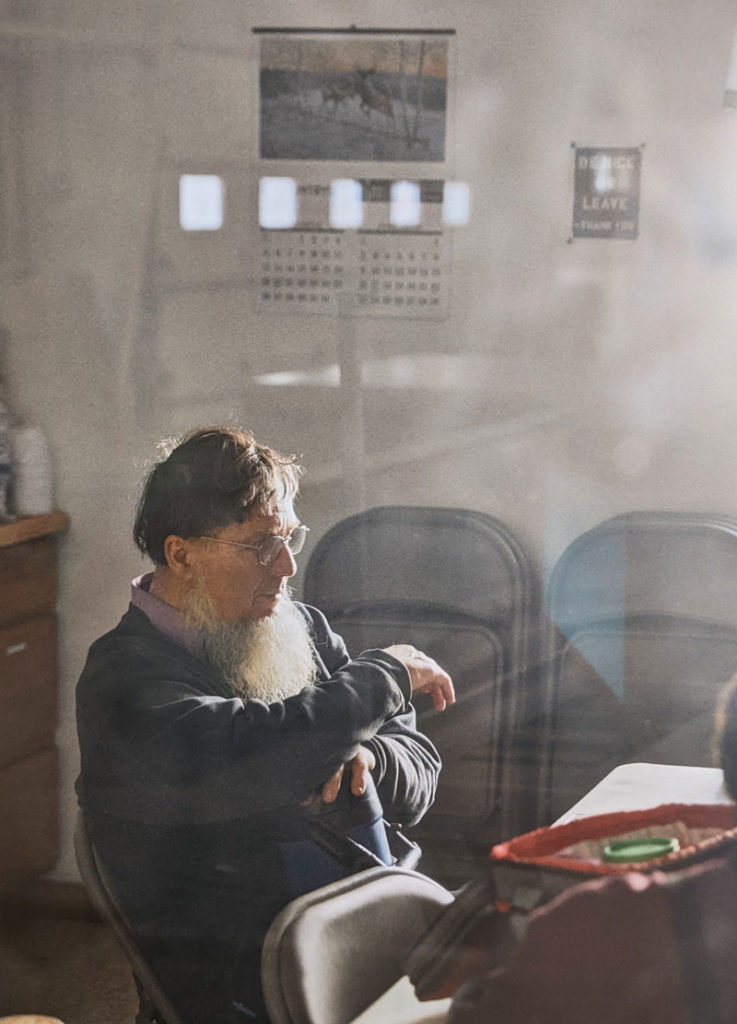
A second series of photographs by Chris Strong takes on the how and couldn’t be more literal. His images go beyond the craftsmanship involved in construction and celebrates the focus, grit and brawn needed to build a house. Capturing faces, unguarded and telling, we gain a very candid and very human understanding of an age-old trade.
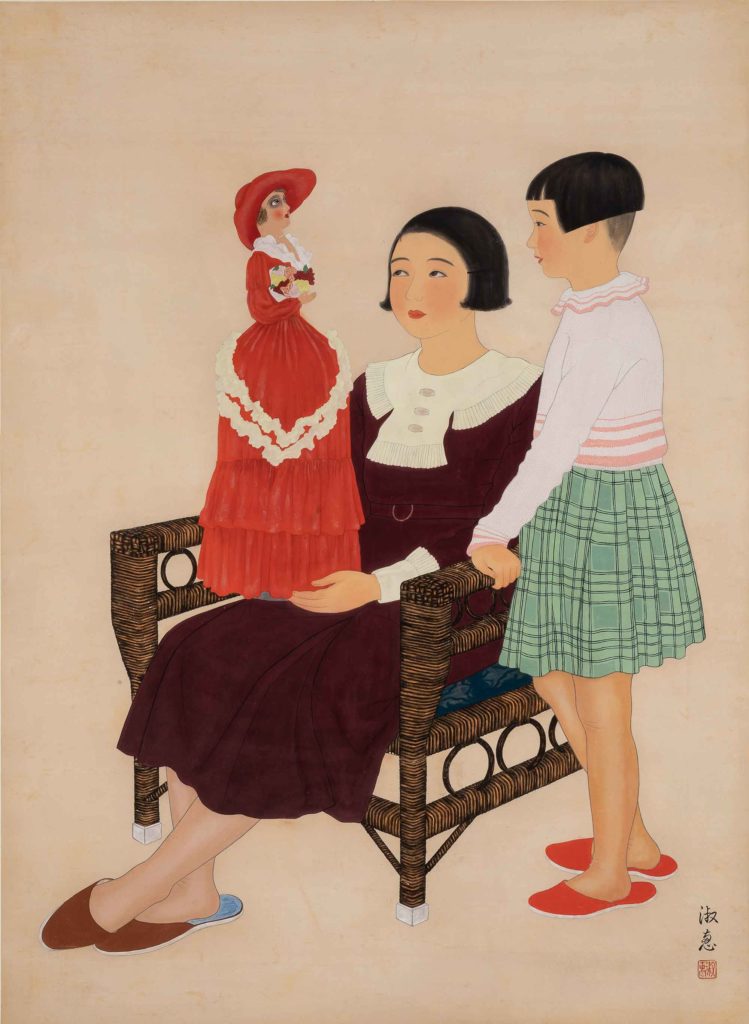
Moga, in Japanese, refers to modern girls. Originating after WWI, the word characterized Japanese women who were attuned to the fashions and lifestyles of the west. It’s also the name of another of the exhibits that opened at the gallery on the 6th. Their shift in clothing style and in the way they wore their hair were documented in art. Chronicled in this way, the images produced became extraordinarily popular and commercially successful. Most of the ten paintings included in Moga: Modern Women & Daughters in 1930s Japan once hung in a lavish Tokyo entertainment complex during the period. Now in the hands of a private collector, David Sneider, they’re once again being given a public showing. So large they seem regal, their size alone gives them impact. And because the figures are so life like, scale brings them close enough to easily take in and admire detail. Most of the time, the western influences are subtle. One figure might be in western dress while others in the same painting wear kimonos. Expressions seem slightly more relaxed then you’d find in more traditional Japanese painting where pose seems more the priority. Japanese art has long glorified the beauty of women and these images are no exception. The scope here has been broadened to also take in the innocence of childhood and youth. Idealistic, remote and beautiful enough to be transportive, the paintings are an enchanting reflection on the manifestations of cultural blending.
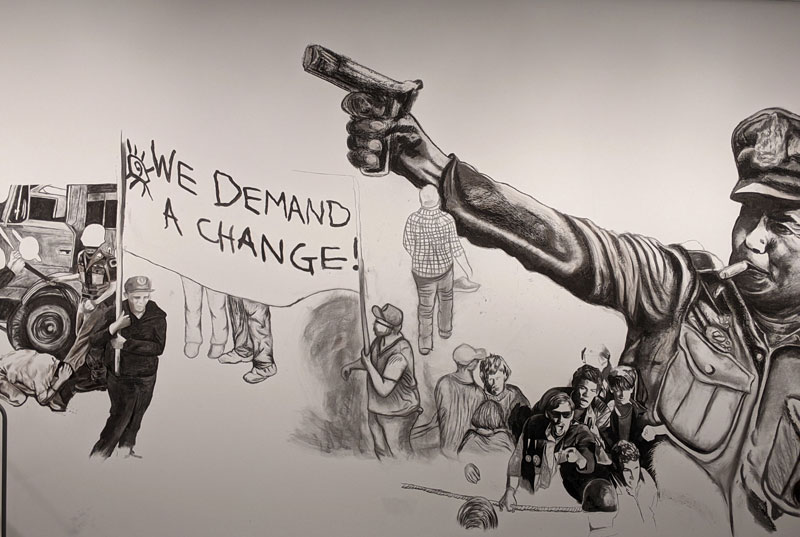
There’s nothing ethereal about Rirkrit Tiravanija: (who’s afraid of red, yellow and green). As contemporary as your last spam text, the combination art/culinary installation may as well be asking, “Who’s afraid of people?” Red, green and yellow refer to the colors adopted by three different factions in Bangkok protesting actions of the Thai government. Just as they were in the exhibit’s original showing at the Smithsonian’s Hirschhorn Museum in 2019, the colors are given a culinary spin. Red, green and yellow curry dishes are served to visitors of the exhibition as they watch artists compose, expand and embellish murals on four expansive walls. The protests they depict vary. Although the current show includes a wall representing the dissent in Bangkok, others tie in Chicago’s history of social turmoil and unrest. Blown up to human scale and covering all four walls, the murals immerse you in a sense of reckoning as they commemorate a common drive to push back oppression or seek justice.
A sleeper exhibit on the top floor of the gallery, We Shall Defy: Shahidul Alam has its own way of delineating the importance of democratic ideals. As an activist artist, Shahidul Alam, a Bangladeshi photojournalist takes pictures of the uncomfortable, makes them entrancing and asks us to not only care, but act. Returning to Bangladesh after a long period of studying abroad, he found the democracy he left had devolved into an autocracy. Documenting with his camera the desperation, corruption, struggle and death that ensued from the change, he reveals and enshrines the reality of a repressive society. He then adds words to his images to give context, point to better alternatives and underscore the resiliency of the Bangladeshi people. Jailed, surveilled and tortured for his work, his drive to use his art as a vehicle for change remain in fatigable. The examples in We Shall Defy are both splendid and sobering.
AMERICAN FRAMING
Rirkrit Tiravanija: (who’s afraid of red, yellow and green)
Moga: Modern Women & Daughters in 1930s Japan
We Shall Defy: Shahidul Alam
May 6 – July 16, 2022
Wrightwood 659
659 W. Wrightwood Ave.
Chicago, IL 60614